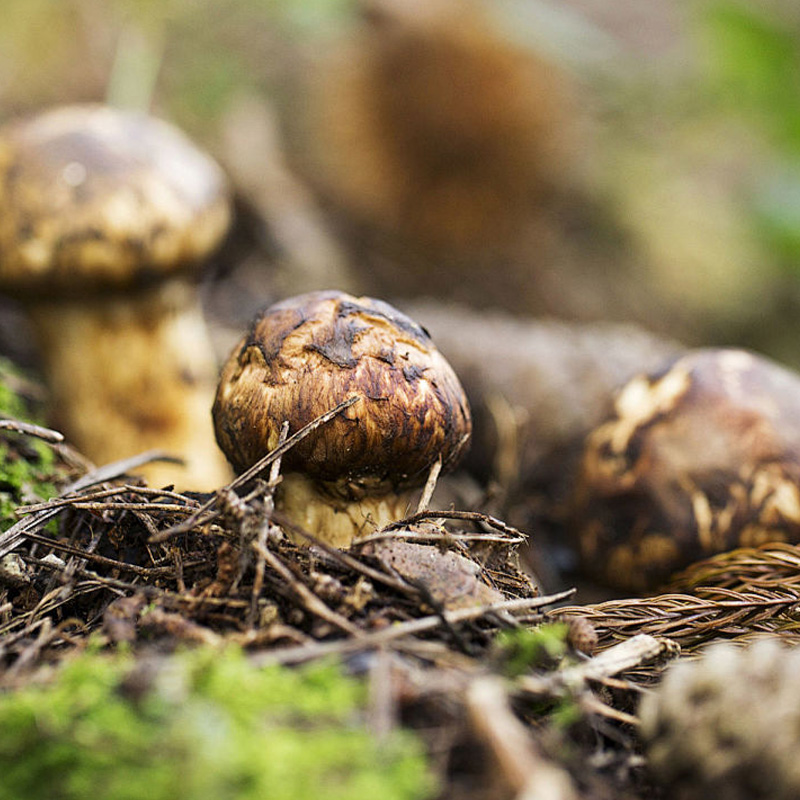TRICHOLOMA MATSUTAKE

TRICHOLOMA MATSUTAKE
Matsutake mushrooms, scientific name Matsutake mushrooms, also known as pine mushrooms, fungi, and Taiwan mushrooms, belong to the subphylum Basidiomycota and family Trichomycteridae. They are ctomycorrhizal fungi of trees such as pine and oak, with a unique and rich aroma. They are rare and precious natural medicinal fungi in the world, and are also a second-class endangered protected species in China. The following is a detailed introduction to matsutake mushrooms:
1、 Origin and output
Main producing areas: The main producing areas of matsutake in China include Shangri La, Chuxiong, Yanbian, Northwest Sichuan (Tibetan areas of Ganzi, Aba and Liangshan in western Sichuan) and the eastern foot of Xizang's the Himalayas. Among them, the Shangri La mushroom producing area accounts for 70% of the total national output and has been the champion of matsutake exports for 30 consecutive years.
Production situation: China is the world's largest producer of matsutake mushrooms, with an annual total output of around 5000-5500 tons. Among them, the northwest region of Sichuan is the largest production area for matsutake mushrooms, with an annual output of around 3000 tons; The production in Yunnan is around 1500 tons; The eastern foot of Xizang's the Himalayas ranges from 300 to 500 tons; The production in Changbai Mountain (Northeast China) is relatively low, around 1000-200 tons.
2、 Nutritional value
Matsutake mushrooms have extremely high nutritional value and are rich in nutrients, including:
Amino acids: Contains 18 types of amino acids, especially with a high proportion of medicinal and essential amino acids.
Trace elements: Contains 14 essential trace elements for the human body.
Active Nutrients: Contains 49 types of active nutrients.
Unsaturated fatty acids: Contains 5 types of unsaturated fatty acids, among which oleic acid, linoleic acid, and palmitic acid have higher content.
Vitamins: Contains 8 types of vitamins, especially vitamin B and vitamin D.
Other ingredients: It also contains 2 types of glycoproteins, rich dietary fiber, and various active enzymes, as well as precious active substances such as double chain matsutake polysaccharides, matsutake peptides, and the world's unique anti-cancer substance - matsutake alcohol.
These ingredients enable Tricholoma matsutake to improve immunity, anti-cancer and anti-tumor, treat diabetes and cardiovascular diseases, resist aging and beautify the face, promote the stomach and protect the liver, and so on.
3、 Eating method
There are various ways to consume matsutake mushrooms, including raw consumption, frying, steaming, and soup making
Steaming: Wash the matsutake mushrooms and steam them directly to maintain their original flavor and nutritional content.
Soup making: Slice the matsutake mushrooms and add them to the cooked chicken soup or clear soup. Bring to a boil and simmer over low heat for a period of time to fully release their nutritional components.
Raw: Wash and slice fresh matsutake mushrooms, then pair them with soy sauce, mustard, and other seasonings to enjoy their unique aroma and taste.
Fry: Slice the matsutake mushrooms and stir well with the eggs until both sides turn golden brown, adding fragrance and making the taste fresher and more tender.
4、 Selection and Storage
Selection: When purchasing matsutake mushrooms, attention should be paid to checking the place of origin, color, odor, appearance, moisture content, and other aspects. High quality matsutake mushrooms should come from high-quality production areas such as Shangri La, with a light yellow or off white color, rich aroma, strong and powerful appearance, and moderate moisture content.
Storage: Fresh matsutake mushrooms should generally not be stored for more than 2 days at room temperature at home, and can be extended to 3-5 days when stored in the freezer compartment of the refrigerator. Beyond this time, the active nutrients of matsutake mushrooms will deteriorate, the aroma will quickly disappear, the color will turn yellow, and the taste will become sour.
Matsutake mushrooms are a rare and precious natural medicinal fungus with rich nutritional value and various health benefits. When choosing and consuming, attention should be paid to selecting high-quality products and appropriate consumption methods.




